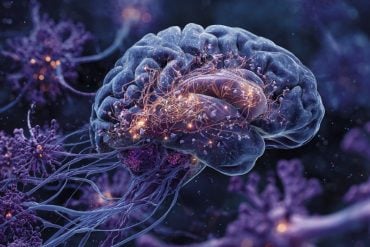Summary: A new study reveals that the brain’s social perception pathway—a network that processes faces, gaze, and speech—is already active at birth or shortly thereafter. Using advanced imaging data, researchers showed that newborns exhibit robust connectivity in regions responsible for visual and social processing.
Infants with stronger early connectivity paid greater attention to faces at four months and displayed fewer social difficulties by 18 months. The discovery sheds light on the neural roots of social behavior and could inform early detection of autism spectrum disorder.
Key Facts:
- Early Activation: The brain’s social perception network is active within weeks of birth.
- Predictive Connectivity: Stronger newborn brain connectivity predicts better facial attention and social outcomes.
- Autism Insight: Findings could help identify early markers for social difficulties linked to autism.
Source: Yale
Paying less attention to faces is one of the key markers of autism spectrum disorder. But while researchers have begun to uncover the brain network that supports processing of social stimuli such as faces, gaze, and speech, little is known about how and when it begins to develop.
In a new study, Yale researchers have now found that this network is already quite active at birth or shortly thereafter, a finding that provides insight into the brain processes that underlie social behaviors later in life.

The study was recently published in Biological Psychiatry: Global Open Science.
The researchers suspected this pathway—known as the social perception pathway—might be functional very early in development.
“Newborns are already showing preference for faces and gaze,” says Katarzyna Chawarska, PhD, Emily Fraser Beede Professor of Child Psychiatry at Yale School of Medicine (YSM) and co-senior author of the study.
First, the researchers used data from the Developing Human Connectome Project, a study funded by the European Research Council that’s collecting brain imaging, clinical and behavioral data, and genetic information from children up to 10 months old.
Using the project’s magnetic resonance imaging data, the researchers assessed the functional connectivity across the brain areas that make up the social perception pathway, which includes regions dedicated to vision processing and an area called the superior temporal sulcus that specializes in processing faces, speech, and gaze information.
“We found that connectivity within this network was already quite robust within a couple of weeks after birth,” says senior author Dustin Scheinost, PhD, associate director of biomedical imaging technologies at the Yale Biomedical Imaging Institute.
The finding suggests that some of the social preferences seen in babies early on might be reliant on this pathway, Chawarska explains.
Brain connectivity is linked to facial attention
The researchers then did a similar analysis with children who had a family member with autism spectrum disorder, which increases their likelihood of developing social difficulties. Within this group, the pathway also appeared to be interconnected at birth, as the researchers had observed in the Developing Human Connectome Project participants.
As they followed this second group of children over time, the researchers found that children who displayed stronger connectivity in the social perception pathway shortly after birth paid more attention to faces when they were 4 months old. Further, greater attention to faces at 4 months old was associated with fewer social difficulties at 18 months of age.
“This suggests that the cortical brain processes that give rise to social attention are likely at play shortly after birth and lay the foundation for development of social engagement skills,” says Chawarska.
The research team—an interdisciplinary collaboration that included several researchers in the Child Study Center, the Department of Pediatrics, and the Department of Radiology and Biomedical Imaging at YSM, as well as the Department of Statistics and Data Science in Yale’s Faculty of Arts and Sciences—is digging further into this area. They are currently looking at additional measures of attention and following a larger group of children over time.
“This work will help us understand more about the brain processes that drive social attention in typical development and that may be involved in the social vulnerabilities we know are associated with autism,” says Chawarska.
Key Questions Answered:
A: Researchers found that it is already active within weeks after birth.
A: It governs how the brain processes faces, speech, and gaze—key elements of social behavior.
A: Babies with stronger early connectivity in this pathway showed better attention to faces and fewer social difficulties later, suggesting early brain wiring shapes social development.
About this social neuroscience and neurodevelopment research news
Author: Mallory Locklear
Source: Yale
Contact: Mallory Locklear – Yale
Image: The image is credited to Neuroscience News
Original Research: Open access.
“Functional connectivity in the social perception pathway at birth is linked with attention to faces at 4 months” by Katarzyna Chawarska et al. Biological Psychiatry: Global Open Science
Abstract
Functional connectivity in the social perception pathway at birth is linked with attention to faces at 4 months
Background
The right-lateralized social perception pathway, including the superior temporal sulcus, supports processing of dynamic, multimodal facial cues, while the right-lateralized ventral pathway, including the fusiform gyrus, is involved in processing static facial features. However, little is known about the early development of these pathways or their links to later social outcomes.
This study examined intrinsic functional connectivity (iFC) in these pathways in neurotypical neonates and those with a familial risk for autism. We also investigated whether neonatal iFC was associated with reduced attention to faces at 4 months—an early autism biomarker.
Methods
IFC was measured in 310 full-term, typically developing neonates from the Developing Human Connectome Project (dHCP) at 41 weeks postmenstrual age (PMA; SD = 1.7), and in 73 full-term Yale neonates with and without a family history of autism at 44 weeks PMA (SD = 1.3). Attention to faces was assessed at 4.1 months (SD = 0.3) via eye-tracking in 37 Yale participants.
Results
All four pathways showed significant iFC (p < 0.001), with no sex differences (p > 0.159). Connectivity in the social pathway increased with age (p < 0.001). In Yale neonates, only iFC in the right social pathway was positively associated with attention to faces at 4 months [r(37) = 0.456, p = 0.006]. Greater attention to faces predicted fewer social concerns at 18 months [r(33) = –0.358, p = 0.010].
Conclusions
Right-lateralized social perception pathway represents an area of interest for identifying early neural markers of social vulnerabilities associated with autism.






